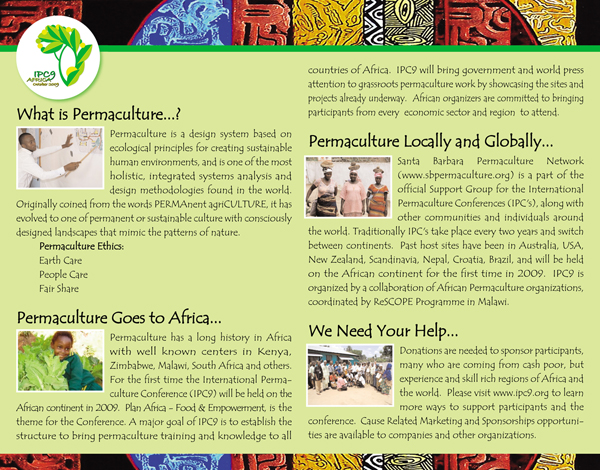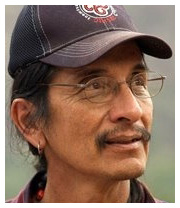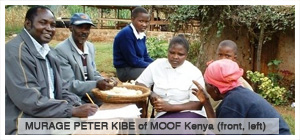More
- On the Road to IPC9 in Ojai
- Some other impressions, mainly from Tanzania
- Permaculture Goes to Africa
- Santa Barbara sponsors Ed Mendoza (USA) & Peter Murage (Kenya) to IPC9
- First Annual Southern California Permaculture Convergence, SB Permaculture Network & Quail Springs Host
PERMACULTURE TALKSTORY
Happy New Year from Santa Barbara Permaculture Network!

long life, honey in the heart...
May your new year be joyful, knowing anything is possible. Like the tiny hummingbird, we are capable of amazing feats.
Flying forward, backwards, switching direction on a dime, adaptable, resilient, enormous energy, capable of flying thousands of miles with hardly anyone noticing the fluttering of its tiny wings, until it arrives, all luminous with exquisite beauty that no one can ignore.
thank you Permaculture for continuing to surprise us and the world with your practical, adaptable, resilient beauty, arriving in the most unlikely places, sharing knowledge & wisdom, both ancient and new.
Happy New Year!
illustration by Martin Prechtel
Santa Barbara Permaculture Network Facebook Page
https://www.facebook.com/pages/Santa-Barbara-Permaculture-Network/200013020012596?ref=ts&fref=ts
We hope you can join us for another year of interesting programs. We have appreciated your support through the years, we officially formed our 501(c)3 educational non-profit in 2000, we have done over 90 programs and workshops in what seems to be a very short time, but has been over a decade now. We have loved every minute, thanks for sharing the journey.
Margie Bushman & Wes Roe
Co-founders, Santa Barbara Permaculture Network Non-profit
On the Road to IPC9; SB Permaculture Network Attends 9th International Permaculture Convergence
Since the scpg@arashi listserve (South Coast Permaculture Guild) came out of the Ojai Permaculture Design course with Bill Mollison in 1997 that was the start of all our work in Permaculture, we thought it would be an appropriate place to share some of our adventures in Africa as we walk towards the 9th International Permaculture Convergence (IPC9). A more official blog can be found on the IPC9 website at www.ipc9.org. We hope you enjoy.

Travel continues to be the best teacher, and we're convinced, even acknowledging disastrous carbon emissions, people need to travel more not less, to understand the realities of the world we live in. We have become very insular as Americans. College age students especially would benefit from six months mandatory in another country similar to those we have been traveling in, a reality check. We have so much, and we barely acknowledge that fact, but more than that, how can we or they plan for a future with such superficial knowledge of this very connected world. Carbon emissions are disastrous, but so are decisions made out of ignorance. Online and virtual is not reality.
Our first stop in an unfamiliar part of the world was Dubai, the best place for flight connections to the part of Africa we were going. Wowee! I don't think they have heard about global warming in Dubai. The place looks like Phoenix on steroids, all shiny and new and growing. And, like many other places you wouldn't expect, totally given over to the car culture, lots of new and big SUVs on the road. The skies are smoggy. Where are the camels, simple desert life, and clean air? How will they survive energy descent? Many from other countries (Pakistan, Iran, India, Asia) coming to Dubai to work, absorbing working populations not able to find work at home. It is seen a place of opportunity.

We went next to Dar Es Salaam in Tanzania, an ancient trade center on the Eastern Coast of Africa. Global trade before ocean tankers and jet planes. Arabs, Indians, Persians, Asians bumping up against the shores of Africa for thousands of years before European contact, influencing its culture and language, giving and taking away. Slavery also ancient practice, not hundreds, but thousands of years old. Swahili, a Bantu language at its core, absorbs all these influences, and is a beautiful language to listen to. When we arrived at the Julius Nyerere airport, named after the revered first President of Tanzania, the electricity was out in the city of 2-3 million, drought in Tanzania making electricity harder to produce. Thousands on the dusty roads walking and using bicycles, many carrying enormous loads. Nevertheless, a huge traffic jam as we made our way to our hotel. Our hotel in one of the endless high rises, like we also noticed in Brazil, a surprise, but a way to house millions in smaller area. They rise out of and in the midst of shanty towns. Our thoughts again, how will they survive energy descent?

Musoma on the shores of Lake Victoria, is our reason for coming to this part of the world. We are visiting Tara Blasco and Lyn Hebenstreit and their organization Global Resource Alliance (GRA), located in Musoma. They are from Ojai, CA, and came to this poor region of Tanzania, when Lyn offered his services to do accounting for any small NGOs needing that kind of help. They are now doing so many projects it is hard to keep track of, how do two people have that much energy? They work with AIDS orphans in two locations, micro-finance projects, started a Permaculture Plot at their Center (Geoff Lawton taught a PDC there last year), studying and documenting the use of Neem for Malaria prevention, and most significantly, are drilling for Primary Water. Primary water is drilled to find water coming out of fissures under great pressure from the Earths mantle, a much cleaner source of water than ordinary pools found in the water table. It is a fascinating subject, and Lyn will be making presentation at the IPC9 to educate others to this little known way of obtaining clean water for communities. People walk for miles to find water, clean or otherwise. We visited several bore holes and pumps to interview those using the new wells and hand pumps, they not only have cleaner water, but burn far less fuel (wood from forests) to boil to make sure safe to drink. The people and the forests benefit. You can visit the GRA website to learn more about this fascinating subject (www.globalresourcealliance.org).
Our most memorable experience was being invited to go along on an annual trip to the Serengeti with GRA staff and the children from two AIDS Orphan centers. GRA felt it just plain wrong that the rest of the world comes to visit the Serengeti and all its amazing wildlife, a national treasure most of these children would never see. Twenty-five children crammed into an old mini-bus, and off we go for a long road trip, kids singing all the way. Not one word of complaint on the long hot journey, all happy to be a part of the adventure. We really did see everything, zebras, wildebeests, giraffes, elephants, a lion and its cubs, hippos, much more. How could we be so lucky? Who would have imagined an adventure like this? It made us feel sorry for those in fancy safari cars traveling the same road, were they having as much fun as us? Probably not.

We have now arrived in Malawi, called the Warm Heart of Africa. In a day the 9th International Permaculture Convergence begins! We are at the Kumbali Lodge, where there is a hotel lodge, but also huts resembling traditional style housing most of us are staying in. The owner from the beginning committed to sustainability, but since his involvement in the IPC9, has converted his already organic gardens to a permaculture model. People are arriving from around the world. Rosemary Morrow, Geoff Lawton, Joel Glanzberg, Ali Sharif, are some of the names we are familiar with, and of course Ed Mendoza and Peter Murage, the two attendees Santa Barbara helped sponsor. But most important are all those coming from African countries, with projects and work we haven't heard of yet. The Malawi government sponsored more than 25 teachers from school and health & nutrtition projects to attend. Wangari Mathai is scheduled to give the opening keynote address. We give thanks and gratitude to all who helped make this event happen, but especially to Walter Nyika, of ReScope, official coordinator, who has worked tirelessly and with great skill to make this event happen. We will share more impressions as the International Permaculture Convergence begins.
Margie Bushman
Santa Barbara Permaculture Network
Some other impressions, mainly from Tanzania
- Almost no one in Tanzania smokes!
- Would be hard to be a vegetarian in Africa.
- Goats, cattle everywhere.
- Everyone uses cell phones, more prevalent than our culture.
- Women dress beautifully, beautiful fabrics and colors, Katangas and sarongs, babies carried in these too.
- Men dress Western, with slacks and long sleeve shirts for the most part, all looking neat and tidy even while walking the dusty hot roads and paths, how do they do it? Africans not accepting of sloppy dress.
- Cars (and motorcycles) rule, you must mind yourself and your kids and animals, stay out of the way, it is your job, and peril if you don't.
- Food boring and repetitious for most, meat, rice & beans, hard porridge (Ugali), but kids look healthier than American kids, as we noticed in Brazil. Their kids will die of malaria and Aids, ours of diabetes and obesity.
- Obama very popular!
- Malaria prevalent, but so are inexpensive clinics to get quick, simple, affordable test ($1) and remedies, Margie's already been in for a visit.
- Growing in the cultivated landscape, bananas, cassava, peanuts, tomatoes, okra, maize.
- Plastic burned to eliminate, no money for recycling centers, terrible for breathing.
- No one in this part of Africa, even in high end hotels, uses plastic to line their trash containers (we could save billions of gallons of oil yearly if Americans ceased to do, probably delay Peak Oil by a decade at least, but I guess we need our tidy bins…)
- Corrugated tin used for roofing, most looking rusty and old.
- The landscape looks worn out, long term human habitation, even though not high end users, taken its toll.
Permaculture Goes to Africa
CLICK HERE to enlarge it.

Africa , where civilization got it's start...
54 countries, 1000 languages, 780 million people, incredible
diversity of cultures and environments...
Africa is at a crossroads. It has the potential to help model a pathway to sustainability for the rest of the world. But currently the African continent is undergoing the most rapid change, and destruction of it's natural resources and cultures, of anywhere in the world.
In 2007 a group of dedicated African delegates arrived at the 8th International Permaculture Convergence in Brazil (IPC8) with the intention of bringing the next Convergence to Africa. They made a successful bid, and worked tirelessly to organize the 9th International Permaculture Convergence in Malawi, exhibiting what permaculture can do for their own countries and the world. With some of the original and oldest permaculture centers in the world located in Africa, they had much to share.
Santa Barbara Permaculture Network non-profit is a part of the official Support Group for IPC's. For IPC9 in Malawi, Santa Barbara Permaculture Network, and generous donors helped sponsor long time permaculture teacher and designer Ed Mendoza, founder of Indigeneous Permacultre de Aztlan, and Peter Murage of MOOF Permaculture Center Kenya, to attend by holding a special fundraising event at the Sola House courtyard, where African music and food was shared by all.
 Eduardo (Ed) Mendoza (Xikano-Nahuatl) is a farmer, poet, activist and Director of Indigenous Permaculture de Aztlan. In 1993 he became an agricultural advisor for the Traditional Native American Farmers Association and started to train in Permaculture. He worked for the Gila River Indian Community, establishing an aquaculture and farming program to teach young juveniles about traditional crops. Ed helped establish the Casa Blanca Growers Cooperative which grows mostly traditional organic crops. He currently works on the Gila River Indian Reservation in Arizona promoting the use and production of traditional crops and seed saving for future generations. Formerly on the Board of Native Seed Search, he remains a consultant working on dietary research related to Diabetes. He is a part of the teaching team for Indigenous Permaculture ( www.indigenous-permaculture.com) with a yearly course in Santa Fe, NM. The purpose of Indigenous Permaculture de Aztlan is to assist indigenous nations learn the means to be economically self sufficient and to respect culture and ceremony, to restore lands for future generations, with youth trained in permaculture and other sustainability skills such as rainwater harvesting, polycultures, aquaculture, and solar energy.
Eduardo (Ed) Mendoza (Xikano-Nahuatl) is a farmer, poet, activist and Director of Indigenous Permaculture de Aztlan. In 1993 he became an agricultural advisor for the Traditional Native American Farmers Association and started to train in Permaculture. He worked for the Gila River Indian Community, establishing an aquaculture and farming program to teach young juveniles about traditional crops. Ed helped establish the Casa Blanca Growers Cooperative which grows mostly traditional organic crops. He currently works on the Gila River Indian Reservation in Arizona promoting the use and production of traditional crops and seed saving for future generations. Formerly on the Board of Native Seed Search, he remains a consultant working on dietary research related to Diabetes. He is a part of the teaching team for Indigenous Permaculture ( www.indigenous-permaculture.com) with a yearly course in Santa Fe, NM. The purpose of Indigenous Permaculture de Aztlan is to assist indigenous nations learn the means to be economically self sufficient and to respect culture and ceremony, to restore lands for future generations, with youth trained in permaculture and other sustainability skills such as rainwater harvesting, polycultures, aquaculture, and solar energy.
 Peter was one of the African delegates who attended the International Permaculture Convergence in Brazil in 2007, and helped make a successful bid to bring the Convergence to Africa in 2009. Our community is also tied to Peter in a very special way. In January 2008 when Kenya was experiencing chaos and violence after their elections, Peter kept us informed about the frightening conditions occurring in his country via email. At one point we lost contact with Peter for an entire month, and in our concern, and then extreme worry, we came together to hold a sacred fire for a 24 hour period, keeping Peter safe in our thoughts. This was facilitated by Warren Brush at Quail Springs Permaculture Farm, in Cuyama Valley. But even for those who could not attend, Warren said they could hold a "virtual" fire with us, and they did! The fire was held sunset to sunset, and the following morning Peter contacted us by email to say he was safe.
Peter was one of the African delegates who attended the International Permaculture Convergence in Brazil in 2007, and helped make a successful bid to bring the Convergence to Africa in 2009. Our community is also tied to Peter in a very special way. In January 2008 when Kenya was experiencing chaos and violence after their elections, Peter kept us informed about the frightening conditions occurring in his country via email. At one point we lost contact with Peter for an entire month, and in our concern, and then extreme worry, we came together to hold a sacred fire for a 24 hour period, keeping Peter safe in our thoughts. This was facilitated by Warren Brush at Quail Springs Permaculture Farm, in Cuyama Valley. But even for those who could not attend, Warren said they could hold a "virtual" fire with us, and they did! The fire was held sunset to sunset, and the following morning Peter contacted us by email to say he was safe.
For the permaculture community, the International Permaculture Convergences (IPC's) are hugely important. Why is there a global permaculture movement? What makes it continue to influence and inspire people, not only in theory, but in hard practical examples of living solutions around the globe? Projects, actual working design strategies, practical skills, and experiences are shared at a Convergence on a personal level, it's an amazing experience for all. This is the "culture" in permaculture, our chance to learn about our friends around the world, this time Africa.
First Annual Southern California Permaculture Convergence August 2008
Santa Barbara Permaculture Network & Quail Springs Host

